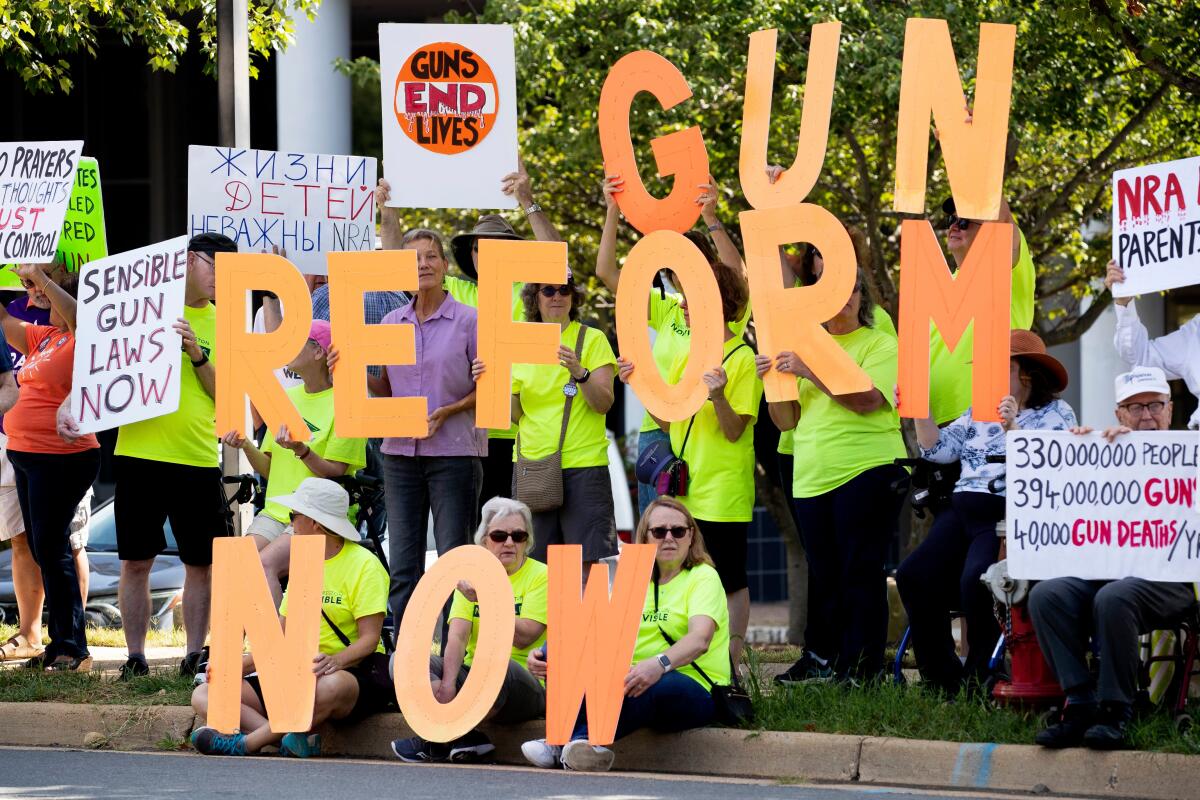Here’s what you need to know about ‘red-flag’ laws, the latest trend in gun control

- Share via
The questions always start immediately after the shooting ends: How did the killer get his gun? Could this all have been prevented?
The recent mass shootings in El Paso and Dayton, Ohio, were no exception, and once again the nation is discussing gun control.
Little has happened at the federal level over the last two decades, but there are signs this time that Congress may find inspiration from the growing numbers of states that have been passing so-called red-flag gun laws.
What are red-flag gun laws?
The laws — also known as extreme risk measures — allow courts to temporarily ban people from possessing firearms if there are clear signs that they pose a danger to themselves or others. The measures vary slightly from state to state, but most of the laws mandate that only specific people — family members or roommates, for example — may petition for such a court order.
How many states have these laws?
A total of 17 states and the District of Columbia have red-flag gun laws, with most passing since the February 2018 mass shooting at Marjory Stoneman Douglas High School in Parkland, Fla. Prior to that shooting, only five states — California, Connecticut, Indiana, Oregon and Washington — had such laws.
Why have so many states acted post-Parkland?
A bipartisan movement was born after evidence emerged that the 19-year-old suspect there showed several signs he was likely to act out violently in the months ahead of the shooting. Family members of the suspect had warned law enforcement that he had posted disturbing messages on social media and that he had expressed a desire to kill. The FBI also acknowledged it had failed to act on a tip ahead of the massacre that left 17 people dead at the school.
At the time, Florida did not have a red-flag gun law. It passed one three weeks after the shooting, setting off the current wave.
“We fully expect more states to look at passing a law of their own … as communities across the country continue to call for their leaders to take decisive action in keeping them safe,“ said Allison Anderman, senior counsel at the Giffords Law Center to Prevent Gun Violence, a nonprofit in San Francisco.
Have these laws worked?
The few studies that have examined that question suggest some benefit.
A study published last year in the peer-reviewed medical journal Psychiatric Services found that red-flag laws lowered suicide rates in Connecticut and Indiana — two of the early states to pass such measures.
Indiana’s firearm-seizure law was associated with a 7.5% reduction in firearm suicides in the 10 years following its enactment, according to the study. Meanwhile, enactment of Connecticut’s law was associated with a 1.6% reduction in firearm suicides immediately after its passage.
In California, where lawmakers passed a measure in 2014, fewer than 200 court-issued orders were doled out across the state during the law’s first two years on the books, according to the state Department of Justice. Many say a lack of public knowledge of the law is a reason it’s seldom used.
Research is limited in large part because of the so-called Dickey Amendment, which was passed by a Republican-controlled Congress in 1996 and stipulates that money appropriated to the Centers for Disease Control and Prevention cannot “be used to advocate or promote gun control.”
What have the politicians said?
Days after the El Paso and Dayton shootings, in which 32 people died, Ohio Gov. Mike DeWine, a Republican, called for lawmakers in his state to pass a red-flag law.
“We have to empower people to get help for family or loved ones who may be a danger to themselves or a danger to others,” DeWine said during a news conference last week.
After the Dayton shooting, a former girlfriend and a friend of the gunman told officials that he had shown a fascination with shootings and seemed likely to act out violently.
In Washington, Sens. Lindsey Graham (R-S.C.) and Richard Blumenthal (D-Conn.) announced bipartisan legislation that would create a federal grant program to encourage states to adopt red-flag laws. Last year, a similar bill stalled in Congress.
In recent days, President Trump and Senate Majority Leader Mitch McConnell (R-Ky.) have expressed support for such legislation.
Speaking to a Kentucky radio station last week, McConnell said the legislation would be “front and center” once lawmakers return from the August recess.
Does the public generally support such laws?
Yes.
A Washington Post poll from last year found that 85% of the public support red-flag laws. In the poll, 92% of Democrats supported such legislation, compared with 84% of Republicans.
What about opposition?
The National Rifle Assn. has worked to defeat red-flag measures in several states and continues to oppose them in the wake of the massacres in El Paso and Dayton.
NRA spokeswoman Amy Hunter said Wednesday that such laws risk infringing on the rights of law-abiding gun owners.
“Extreme Risk Protection Orders at a minimum must include strong due process protections, require treatment, and include penalties against those who make frivolous claims,” she said.
More to Read
Sign up for Essential California
The most important California stories and recommendations in your inbox every morning.
You may occasionally receive promotional content from the Los Angeles Times.











